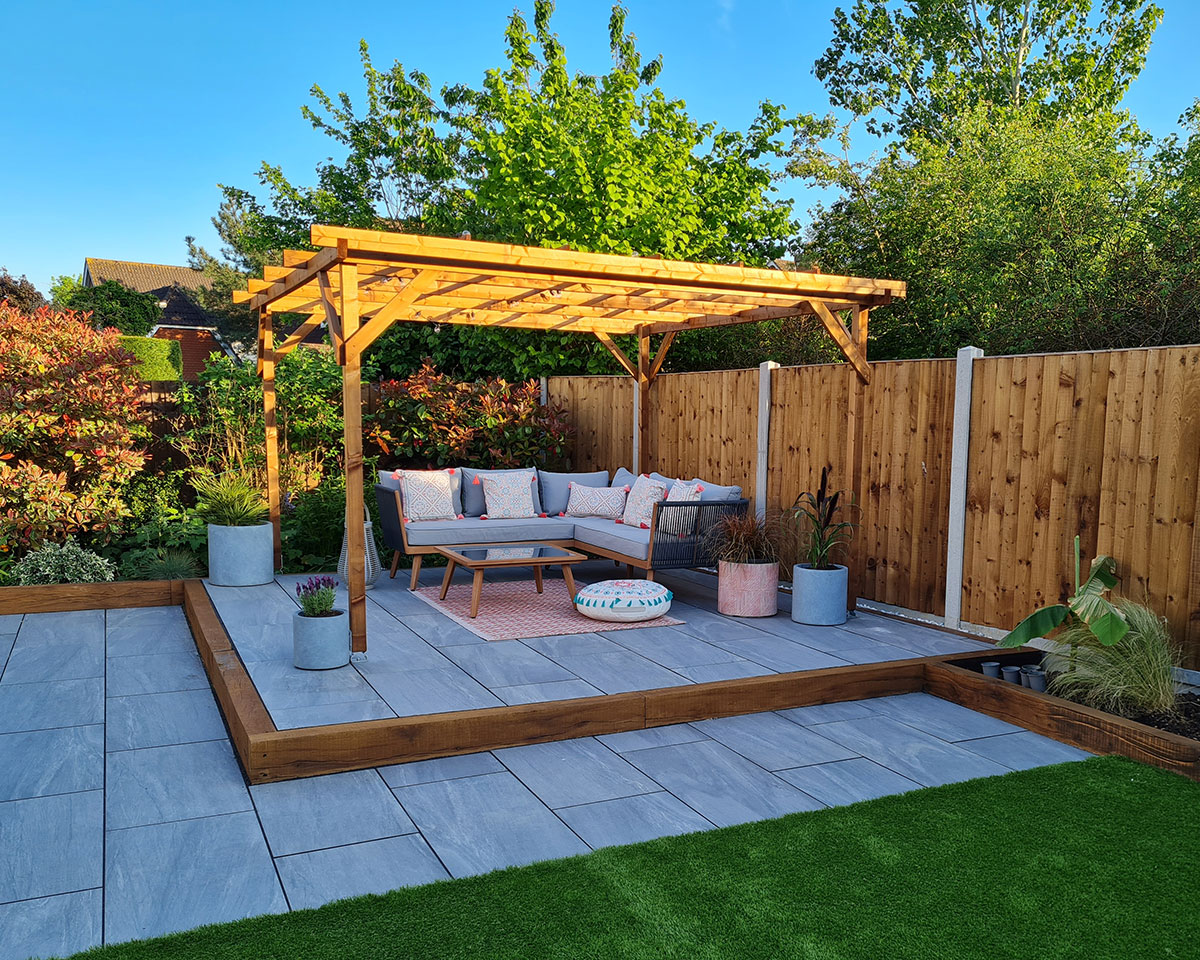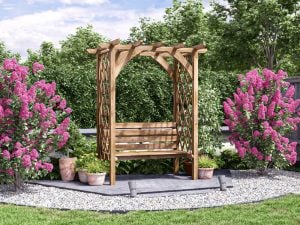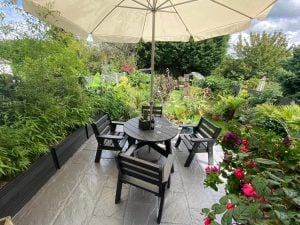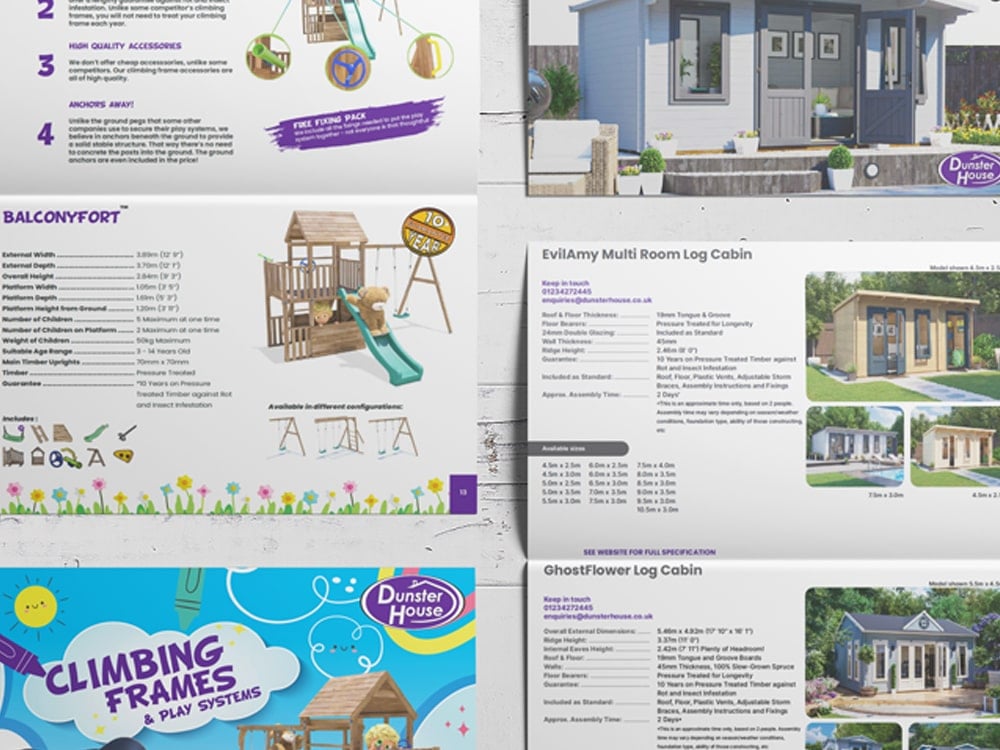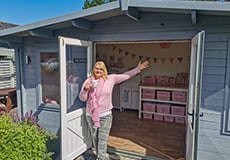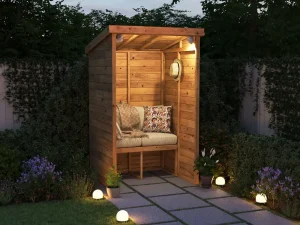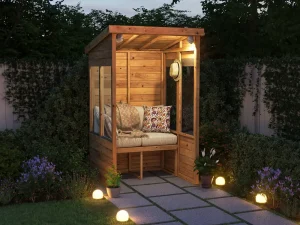Materials
Timber
Let’s start strong! Wood is obviously one of our favourite materials to work with and a brilliant option for garden furniture. It is very versatile in its features, and it can be crafted in a way that minimises its natural faults, such as knots.
Pros
Strength and Stability
The mighty oak – how old and strong is it? Enough said indeed.
Beautiful natural aesthetic
For most gardens what comes to mind is grass flowers plants trees… see where we are going with this, wooden furniture perfectly fits the aesthetic of most gardens.
Sustainable
Wood is a renewable resource. Make sure to look for companies who take pride in responsibly sourcing their timber… like us.
Comfort
It may not be soft like a pillow, but have you sat on some materials in extreme heat or cold? It can make things so much worse! Timber is a bad conductor so it isn’t going to reflect the weather.
Cons
Maintenance
Maintenance is one of the few downsides to picking wood. It is manageable depending on the type of wood you choose, how the manufacturer has pre-treated it, the type of treatment you choose, etc. If you want to learn to care for your timber we have an article on just that.
Natural Defects
Warps, knots, twists, splits, shakes. To some, these are insurmountable barriers to the purchase of timber. Yet for some, they are the charming characteristics of a natural product that help give it character. It is dependent on personal preference.
Wicker/Rattan
These are actually two different things but are often used synonymously (yes we see the irony). Wicker refers to a certain weave style, whereas, rattan is a material made from natural abaca strands.
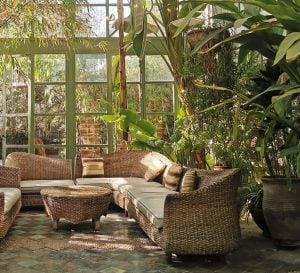
Pros
Light
Rattan, and wicker, are one of the more lightweight options for outdoor furniture. This makes it great for moving it around.
Classic
Wicker is a classic design style for outside furniture. Also, there’s a reason why when you think wicker you associate it with rattan. They are a timeless pairing. Even if rattan isn’t the material for you there are more modern alternatives, such as plastic/resin.
Sustainable
Rattan (not the plastic wicker alternatives) is a renewable material and is recyclable.
Cons
Protection
Rattan will need a relatively high level of care and maintenance as it is vulnerable to extreme weather conditions. It tends not to like very wet weather (not that we can blame it) as it can get moisture damage and weaken. Even large amounts of sun exposure can cause it to fade. Therefore, you may find yourself needing to store your outside furniture inside… or you could get a garden shed as a storage option.
Cleaning
As this is a weave style of construction it comes with all the little grooves and gaps that come with weaves. Trying to get into all those nooks and crannies will require time and care, which you should take into consideration. Cleaning will also come with varying degrees of difficulty depending on the material you decide to go for.
Plastic
If you opt for a plastic wicker set of garden furniture it will come with the pro but also the cons of plastic. Read more about that below.
Plastic
Pros
Price range
Plastics come in a wide range of prices. Even an extremely quick search from me showed garden furniture sets from £50 – £1500 (approx.) so whatever your budget you can find something for you.
Care
Plastics have to be one of the easiest materials to care for. No treatment is needed. Minimal effort when cleaning. If you’re short on time you may want to put plastics on your list of materials to consider.
Cons
Quality range
With great price range comes great quality range. We’ve all seen the products at the bottom of that range and if you have a beautiful garden the last thing you want to do is add an eyesore.
Sticky situation
Heat retention is a factor to consider when choosing plastic. Most of us use our gardens the most in summer, when the sun shines, and it gets hot. We wear shorts, tank tops, and sun cream. So, as you guessed, things can get sticky.
Sustainability
Plastic takes from 20-500 years to decompose, which might mean your product has longevity, but it is damaging our environment. Not only is plastic a significant contributor to global waste, but its manufacturing process also produces CO2. In comparison, resin is viewed as a more environmentally friendly version if you have your heart set on that look.
Metal
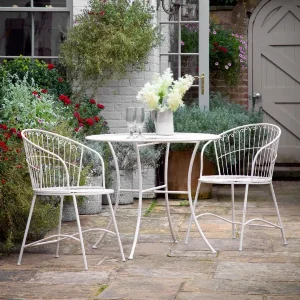
There are many different types of metal and what may apply to one won’t necessarily be true for another.
Pros
Durability
There’s a reason metal is a classic material for outside furniture. Its durability makes it brilliant for outdoor use, as it is less likely to get damaged by adverse weather conditions if properly maintained. The density of metals in general provides extra stability; this boosts the overall durability.
Range of Style Options
You can find metal furniture available in various designs and finishes, it can add a modern or classic touch to any garden or patio. From intricate patterns to minimalistic designs there’s something to suit everyone’s tastes.
Recyclable
Most metal types, like aluminium and steel, are recyclable, making them an environmentally friendly choice.
Cons
High conductivity
I think we can safely say that the majority of metals have quite a high conductivity (look at that GCSE science knowledge in action). That means if it’s hot, you risk getting scalded. You also have the uninviting and unwelcome cold in the winter.
Rust
Now this is dependent on the type of metal you use, stainless steel is infamous for its ability to rust. While many metals are treated to resist rust, untreated or poorly maintained furniture can corrode over time, especially in moisture-dense environments.
Comfort
Due to the aforementioned conductivity and the solidity of metal, it loses points when it comes to comfort. You can combat this by using cushions, however these would likely need to be stored away in adverse weather.
Care and Maintenance
Most of these materials will respond well to a combination of soap and water for cleaning (no harsh chemicals). Some of the more durable materials – hardwood, metal, tough plastics – can be pressure washed.
Some of these materials will need shelter from harsh weather conditions. Rattan and rusting metal will need to be covered from the rain. This can be accomplished by storing them away when they not in use, for which a shed would be ideal. Another solution is using a gazebo so that you can use and admire your garden furniture no matter the weather (with the added bonus of not having to faff around moving them).
Uses
Garden furniture encompasses many different structures, from dining sets to sofas to arbours. You just have to decide what you want the garden furniture to be used for. This can also affect the sort of material you oft for.
Dining Sets
For those of you who are looking for outdoor dining options, the obvious answer is dining sets. For these, you want to look for something easy to clean. Plastic or resin would be a good material for this. If you love your BBQs in the summer and wish you could get the same use out of your garden in the winter, consider a gazebo to shelter your dining area.
Lounging Furniture
Sitting around with friends, bathing in the sun, enjoying the nature around you – it is the ultimate comfort. The only thing missing is having the perfect seating arrangement; may we suggest outdoor lounging furniture. From our list of materials, rattan wicker furniture would likely be the most comfy as the weave allows for a little flexibility and movement and rattan is a bad thermal conductor. However, outdoor fabric furniture is gaining more popularity in the garden furniture market and is worth a look at.
Focal Furniture
Trying to choose between getting some garden furniture and having a focal point in your garden. Why decide? Decorative furniture such as an arbour or a pergola with a seat could be the perfect solution for those of us who want garden furniture that compliments the aesthetics of the garden.
The best material for this is wood, it has the stability to support flowers or lights without moving. Also, its natural appearance beautifully blends with the nature of your garden.


